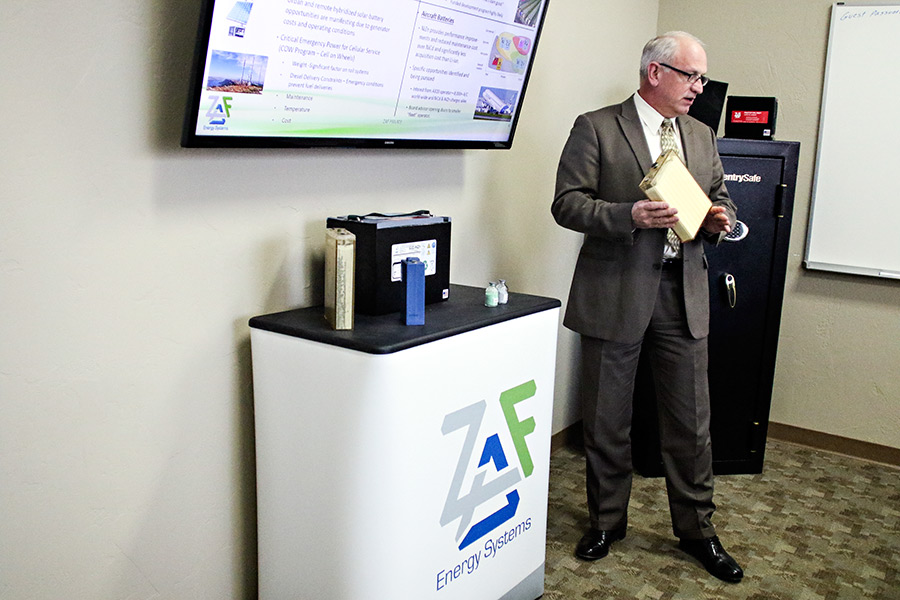COLUMBIA FALLS — In 1859, French physicist Gaston Planté invented the first rechargeable battery, a technological breakthrough that set the stage for the industrial revolution.
More than 150 years later, Planté’s lead-acid battery has evolved through numerous iterations but the electrochemistry at the core of his invention remains largely the same. Most prominently, lead-acid batteries are fundamental to traditional motor vehicles, but they also factor critically in a variety of applications that enable portable electricity, including consumer items and medical devices.
Yet the drawbacks of Planté’s archaic technology are becoming increasingly evident. A report published last year by NGOs Pure Earth and Green Cross Switzerland blamed lead-acid car batteries for being the world’s No. 1 source of chemical pollution. The two primary contents of the battery — lead and sulfuric acid — are highly toxic, hazardous materials that can cause serious environmental and human health concerns, particularly in developing nations.
Advances in electrochemistry have also begun to render the antiquated lead-acid battery technology inefficient, both financially and operationally.
Just as the world is undergoing a technological revolution that is redefining the composition of everyday products, such as electric vehicles, batteries are poised for a makeover.
That’s where a startup company in the electrochemistry hub of the Flathead Valley comes in.
ZAF Energy Systems, a technology firm located along the thriving entrepreneurial corridor of U.S. Highway 2, is striving to develop the next generation of battery technology that could help power motor vehicles, infrastructure and aircraft.
The company believes it has found a viable replacement to traditional lead-acid batteries by blending together the active ingredients of nickel, zinc and potassium hydroxide. The result is a technology that is safer, cheaper and more effective than its lead-acid predecessor, according to company officials.
“We think our mission statement is pretty ambitious but attainable: We’re going to change the way we power the world,” Randy Moore, president and CEO, said last week.
The story of ZAF’s inception is rooted in the Flathead Valley’s uniquely fertile ground for electrochemistry research and development.
In 1979, Ray Thompson, a mechanical engineer, established Semitool in the Flathead as a small high-tech startup that evolved into a global designer and manufacturer of semiconductors. Semitool became a world-class source of chemical engineering in this relatively unassuming corner of Montana. In 2010, Applied Materials, one of the leading developers of the equipment that makes the world’s most popular electronics, acquired Semitool and still operates a business unit in Kalispell.
“I wouldn’t have moved here if Ray Thompson wouldn’t have opened Semitool,” said Craig Wilkins, the vice president of business development at ZAF and the co-founder of Zinc Air, a large-scale energy storage company that started in Columbia Falls in the mid 2000s. “They built our first prototype.”
Zinc evolved into ViZn, which has devoted the last decade to creating battery systems that can attach to a combination of renewable energy sources, such as solar panels and wind turbines, or even the grid. These state-of-the-art large-scale batteries are crafted at ViZn’s research and development site along Highway 2.
In 2011, ZAF became a fully independent spinoff of ViZn and has focused its attention most recently on the prospects of nickel-zinc battery technology.
“The amount of electric chemistry expertise that’s up here is incredible,” Wilkins, a fourth-generation Montana native from Helena, said of the Flathead. “The more you can promote it and the more you get it out there, you’ll attract people and then they’ll spin off their companies and it creates that ecosystem … To be able to build and grow jobs here is critical.”
Wilkins considers ZAF to be on the brink of accomplishing that goal. The company has recently bolstered its administrative staff and is in the midst of a capital investment campaign to help fund the creation of a manufacturing plant in Joplin, Missouri. Many of the company’s prototypes have already been manufactured and shipped for testing, but officials want the opportunity to build the products themselves in some instances. While the manufacturing plant would be in Missouri, the research and development would remain in the Flathead, where roughly 20 employees work.
The company has targeted specific markets that are well-suited to utilize its unique batteries. These markets include long-haul delivery vehicles, military data centers, aircraft and portable telecommunications infrastructure.
“In order to get to market and beat the market, you’ve got to be a better price, you’ve got to be safer and be better performing,” Moore said.
ZAF’s batteries provide three times the power and twice the lifespan of a similar form of lead-acid battery, all without the maintenance of lead-acid batteries, Moore said. Unlike lithium ion batteries, which are used in many handheld devices, ZAF’s batteries are not flammable nor at a risk of being explosive.
Moore said the company is focused on constantly achieving technical improvements, but there are not any “showstoppers” that could halt progress.
“Not only can we prove we can make batteries at scale, now we can go out to the market without worrying that our technology will be challenged,” Moore said.
“Sustainability is a big part of our company, because by introducing nickel zinc to the market, we will be able to take lead and sulfuric acid out of the environment. Those are both bad things. We think by doing that we will improve the sustainability of our planet and the lives of millions.”
